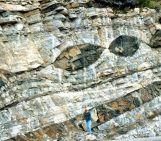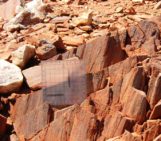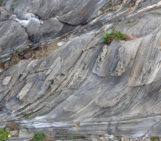
Ramsay’s 1980 important contribution is a practical and theoretical handbook about shear zones, where the reader can find a detailed classification of shear zones, their description, and mathematical explanation.
A definition of the concept of shear zones opens the article, followed by the shear zones classification into three types, namely brittle (e.g., Fig. 1a), brittle-ductile (e.g., Fig. 1b), and ductile.

Figure 1 – a) Conjugate brittle shear zones; (b) En échelon brittle-ductile shear zone: quartz filled vein fissures in a sandstone. From Ramsay, 1980.
For each shear zone, Ramsay lists its characteristic geometrical features according to their displacement field, which is in turn determined by the boundary conditions. The walls of a shear zone can be either unstrained or heterogeneously strained, and generate displacement fields dominated by simple shear, volume change, or a combination of both. The mathematical descriptions of the shear zones deformation are also provided.
Most of the contribution is dedicated to simple shear zones, their fabrics (newly formed and pre-existing), and their terminations, but shear zones with volume change and conjugate shear zones are also considered. The final section addresses shear zones at the regional scale, focusing on the relationship between deep-ductile and shallow-brittle shear zones, under contractional and extensional conditions.
The discussion, to which Samuele Papeschi, Gianluca Frasca, and Silvia Crosetto contributed, highlights the accuracy of drawings and descriptions of shear zones (including their mathematical explanation), confirmed by their use in most of the current teaching material. Most importantly, Ramsay was the first author to define shear zones as localised and to distinguish brittle-ductile, ductile, and brittle shear zones, although new terms such as plastic/crystal plastic have been introduced since. Equally relevant today are his considerations about (i) termination of shear zones and compatibility problems, and (ii) propagation, intersection and merging of shear zones.
Ramsay’s work is still very relevant nowaday, as it paved the road to numerical and analogue modelling of shear zones. Current models focus on exploring more complex and realistic situations, mainly concerning two points: the evolution of shear zone networks and the consequence of geometric irregularities in shear zones.
Comments in the discussion also briefly refer to the active debate about sheath folds that was going on at the same time, as demonstrated by contemporaneous contributions such as Quinquis et al. (1978) or Cobbold and Quinquis (1980).
Written by Silvia Crosetto, Gianluca Frasca, Adriana Guatame-Garcia and the TS Must Read team
References
Cobbold, P.R., Quinquis, H. (1980) Development of sheath folds in shear regimes. Jour. of Struct. Geol., Vol.2, Issues 1–2, pp. 119-126, https://doi.org/10.1016/0191-8141(80)90041-3.
Quinquis, H., Audren, C., Brun, J., Cobbold, P.R. (1978) Intense progressive shear in Ile de Groix blueschists and compatibility with subduction or obduction. Nature 273, 43–45, https://doi.org/10.1038/273043a0
Ramsay, J.G. (1980) Shear zone geometry: A review. Jour. of Struct. Geol., Vol.2, Issues 1–2, pp. 83-99, https://doi.org/10.1016/0191-8141(80)90038-3.





Tapos Kumar Goswami
Thanks a lot for informing us. These papers are always helpful specially in the field.
David Fernández-Blanco
Happy to read that we bring value! Do join our discussions of the papers!